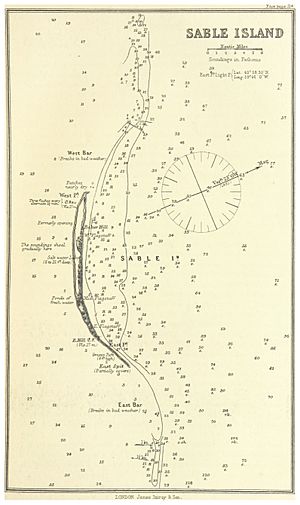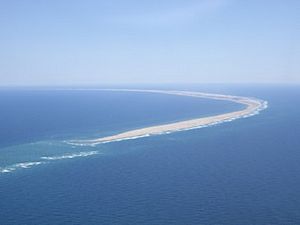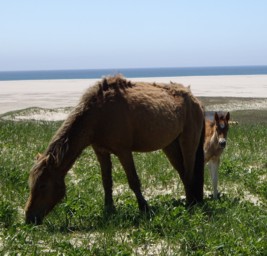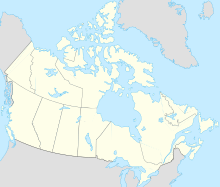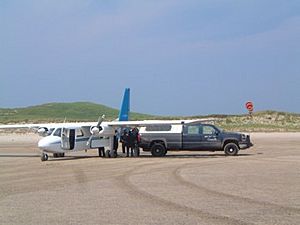Sable Island facts for kids
Quick facts for kids
Sable Island
île de Sable
|
|
|---|---|
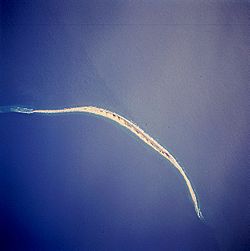
Island from Space Shuttle, April 1994. North is in the lower left corner.
|
|
| Country | Canada |
| Province | Nova Scotia |
| Municipality | Halifax Regional Municipality |
| District | 13 |
| Area | |
| • Land | 31 km2 (12 sq mi) |
| Population | |
| • Total | 0 (6-25 personnel from Meteorological Service of Canada are stationed on Sable Island on rotation at Sable Island Station only) |
| • Density | 0/km2 (0/sq mi) |
| Time zone | UTC−04:00 (AST) |
| • Summer (DST) | UTC−03:00 (ADT) |
| GNBC Code | CBRQR |
Sable Island (French: île de Sable, literally "island of sand") is a small Canadian island situated 300 km (190 mi) southeast of Halifax, Nova Scotia, and about 175 km (109 mi) southeast of the closest point of mainland Nova Scotia in the North Atlantic Ocean. The island is staffed year round by four federal government staff, rising during summer months when research projects and tourism increase. Notable for its role in early Canadian history and the Sable Island horse, the island is protected and managed by Parks Canada, which must grant permission prior to any visit. Sable Island is part of District 7 of the Halifax Regional Municipality in Nova Scotia. However, the Constitution of Canada specifically names the island as being under the authority of the federal government. The island is also a protected National Park Reserve and an Important Bird Area.
Contents
History
Early history
The expedition of Portuguese explorer João Álvares Fagundes explored this region in 1520–1521 and they were among the first Europeans to encounter the island. It is likely that he named the island "Fagunda" after himself. An island called Fagunda appears on later Portuguese maps placed to the southeast of Cape Breton, fairly near its present location; however, the identification of Sable Island with Fagunda is not certain. On the other hand, 16th-century Portuguese sources describe a fishing colony founded by the navigator in Cape Breton Island, further north. It is also possible that Fagundes sighted the island while heading southwest, reaching the Bay of Fundy, as the 1558 map of Diogo Homem and later Samuel de Champlain suggested, but this is unclear. The island was inhabited sporadically by sealers, shipwreck survivors, and salvagers known as "wreckers."
Troilus de La Roche de Mesgouez attempted to colonize the new world with convicts in 1598. When the convicts mutinied, they were left on the tree-less and stone-less Sable Island. Most of the settlers died, but a few managed to survive in mud dwellings for 5 years before being returned to France in 1603.
Shipwrecks
Sable Island is famous for its large number of shipwrecks. An estimated 350 vessels are believed to have fallen victim to the island's sand bars. Thick fogs, treacherous currents, and the island's location in the middle of a major transatlantic shipping route and rich fishing grounds account for the large number of wrecks. The first recorded wreck was the English ship Delight in 1583, part of Humphrey Gilbert's Newfoundland expedition. There were at least three incidents of ship-wrecks in the 1700s. In 1736, a well known Presbyterian preacher Irish-born, Rev. Robert Dunlap (1715-1776), wrecked on the island on his way to America. Decades later, there were two major shipwrecks: In November 1760, Major Robert Elliot (1715-after 1765) of the 43rd regiment was shipwrecked on Sable island—he was rescued in January 1761. En route to Prince Edward Island under the command of Major Timothy Hierlihy, Lieutenant Anthony Kennedy and 25 men wrecked on the island in November 1778. The crew was stranded on the island for the winter. Two died, and the remainder were rescued and transported to Halifax the following April. It is likely that the construction of lighthouses on each end of the island in 1873 contributed to the decrease in shipwrecks.
The last major shipwreck was the steamship Manhasset in 1947. Her crew were all saved, the last significant rescue of the Sable lifesaving station. After the 1991 Perfect Storm, the commercial fishing vessel Andrea Gail's emergency position-indicating radio beacon (EPIRB) was discovered on the shore of Sable Island on November 6, 1991, nine days after the last transmission from the crew. Other items found were fuel drums, a fuel tank, an empty life raft, and some other flotsam. All crew members perished and were never found. No further wrecks occurred until 1999, when the three crew members of the yacht Merrimac survived after their sloop ran aground due to a navigational error. Few of the wrecks surrounding the island are visible, as they are usually crushed and buried by the sand.
The Nova Scotia Rescue Station
A series of life-saving stations were established on Sable Island by the governor of Nova Scotia, John Wentworth, in 1801. The rescue station began the continuous human presence on the island which continues today. Wentworth appointed James Morris, a Nova Scotian veteran of the British Royal Navy as the first superintendent of the island. Morris settled on the island in October 1801 with his family. By the time Morris died on the island in 1809, he had built up the humanitarian settlement to include a central station, two rescue boat stations, several lookout posts and survivor shelters. The station's rescue equipment was upgraded in 1854 with the latest generation of self-bailing lifeboats and life cars through the fundraising efforts of social reformer Dorothea Dix who had visited the island in the previous year.
After Confederation and creation of a weather station
The Canadian government took over administration of the station with Confederation in 1867 and added two lighthouses in 1872, Sable Island East End Light (cylindrical skeletal tower built 1980s, replacing earlier iterations from 1873, 1888, 1917 and 1951) the eastern tip and Sable Island West End Light (pyramidal skeletal tower built 1979 replacing earlier towers from 1873, 1903 and 1935) on the western end. Until the advent of modern ship navigation, Sable Island was home to the families of the life-saving crews and the lighthouse keepers. In the early 20th century, the Marconi Company established a wireless station on the island and the Canadian government similarly established a weather station. Several generations of island staff were born and raised families of their own on the island, although a decline in shipwrecks gradually reduced the size of the lifesaving community. Only two people have been born on Sable Island since 1920.
Improvements in navigation led to a dramatic drop in shipwrecks by the mid 20th century. As such, the rescue station on Sable was reduced and eventually closed in 1958. The Canadian Coast Guard (CCG) first automated in the 1960s and eventually decommissioned the West light station in 2004 leaving only the East lighthouse active. However, during this period, the island's role in science grew, first in weather research. The Canadian government expanded the collection of weather data originally started by the rescue station into a full meteorological station operated by Environment Canada and Department of Fisheries and Oceans. The station conducted routine atmospheric and meteorological studies from a permanently occupied station on Sable Island until Aug 20, 2019. In addition to weather studies, research on the island expanded to a range of ecological and wildlife studies due to its unique position in the Atlantic.
Sable Island is specifically mentioned in the British North America Act 1867, Part 4, Section 91 as being the special responsibility of the federal government ("...the exclusive Legislative Authority of the Parliament of Canada extends to [...] 9. Beacons, Buoys, Lighthouses, and Sable Island."). For this reason it is considered a separate amateur radio "entity" (equivalent to a country for award credit), and with visiting operations using the special callsign prefix CY0. Because it is a separate radio entity, Sable Island is a popular Dxpedition destination.
Out of concern for preserving the island's frail ecology, all visitors to the island, including recreational boaters, require specific permission from Parks Canada. Sable Island's heliport contains emergency aviation fuel for search and rescue helicopters, which use the island to stage further offshore into the Atlantic. Should the need arise, the island serves as an emergency evacuation point for crews aboard nearby drilling rigs of the Sable Offshore Energy Project.
The Canadian Forces patrols the area using aircraft and naval vessels, partly due to the nearby presence of natural gas and oil drilling rigs and an undersea pipeline, all of which were created after the 1983 Canada-Nova Scotia Offshore Agreement and the implementing Act that was finalized in 1988.
National Park
On October 17, 2011, the Nova Scotia government entered into an agreement with the federal government to eventually protect the Island as a national park. The news followed an announcement made by the federal government in May 2010, increasing the level of protection the island receives by transferring control from the Canadian Coast Guard to Parks Canada, which manages the island under the National Parks Act.
Sable Island became a National Park Reserve on June 20, 2013 with approval of Mi'kmaq stakeholders. Full national park status has yet to be achieved, pending settlement of native land claims. The park is home to hundreds of species of flora and fauna including a breed of the unique Sable Island horse. The park is also a breeding ground for marine life.
In July 2016, a hike across Sable Island was added to Google Streetview. Google worked with Parks Canada to add the interactive views of Sable and five other Canadian National Parks. The imagery was collected in September 2015 by a Parks Canada employee who carried a backpack version of the Street View car camera around an area on the centre of the island, part of Google's Trekker program which explores off-road scenic locations. The route follows a hiking route that Parks Canada staff uses to escort adventure tourists who visit the island.
Geography
Sable Island is a narrow, crescent-shaped sandbar with a surface area estimated around 34 km2 (13 sq mi). Despite being approximately 43.15 km (26.81 mi) long, it is only 1.21 km (0.75 mi) across at its widest point. The long crescent-shaped island rises gently from the shallows of the continental shelf approximately 285 km (177 mi) east of Halifax, Nova Scotia. Its location, in tandem with the area's frequent fog and sudden strong storms e.g. hurricanes and nor'easters, have resulted in over 350 recorded shipwrecks. It is often referred to as the Graveyard of the Atlantic, as it sits astride the great circle route from North America's east coast to Europe. The nearest landfall is 160 kilometres (99 mi) to the northwest near Canso, Nova Scotia.
Sable Island is believed to have formed from a terminal moraine deposited on the continental shelf near the end of the last Ice Age. It is slowly moving as waves erode the western shore and new sand is added on the eastern shore, and continually changing shape through the effects of strong winds and violent ocean storms.
The island has several freshwater ponds on the south side between the station and west light; however, in recent years their protecting dune-line has been eroded to such an extent that they are changing from one year to the next. In prior years, a brackish lake named Lake Wallace existed in the centre of the south beach. At its largest, it extended for many miles; indeed, during World War II, amphibious aircraft landed on it. Over the years, the lake shrank with an infilling of sand, until in late 2011, it filled in entirely and disappeared. Since the south beach is subject to flooding during fall storms, photos often show water in the area around the former location of Lake Wallace; however, this flooded area is relatively shallow (only a few feet at most) and is not a remnant of the lake. The original lake was of a significant enough depth that even during times when the area was flooded, the lake could be seen in aerial photographs as a darker (deeper) patch in the middle of the flooded area.
The island is a part of the Halifax Regional Municipality, the federal electoral district of Halifax, and the provincial electoral district of Halifax Citadel, although the urban area of Halifax proper is some 300 km (190 mi) away on the Nova Scotian mainland.
Climate
Sable Island has a humid continental climate (Köppen Dfb), but its climate is strongly influenced by the sea. As such, winter temperatures average near freezing while during the summer months, daily maximum temperatures average around 20 °C (68.0 °F). The average annual temperature range in Sable Island is only 18.6 °C (33.5 °F) owing to the influence from the sea compared to 24.3 °C (43.7 °F) at Halifax and 38.9 °C (70.0 °F) in Winnipeg. Generally, February is the coldest month while August is the warmest month. Sable Island averages 1,372 millimetres (54.0 in) of precipitation a year, which is fairly evenly distributed throughout the year, though October through January are the wettest months due to frequent and intense fall and winter storms. Being located in the path of major frontal storms and tropical cyclones year-round, most of the precipitation comes from these storms. Thunderstorms are rare, with only 11 days with thunderstorms per year. There are frequent heavy fogs in the area due to the contrasting effects of the cold Labrador Current and the warm Gulf Stream: on average there are 127 days out of the year that have at least 1 hour of fog. This makes Sable Island the foggiest place in the Maritimes. The foggiest season is during the summer months where July averages 22 fog days. During the winter, Sable Island has the warmest temperatures in Canada apart from the Pacific coast, and can have the warmest temperatures in the country on some occasions due to the influence of the Gulf Stream. Summers are among the coolest in southern Canada though. It is also the most hurricane-prone part of Canada, also due to the Gulf Stream, and is the only place where Category 3 hurricane-force winds are likely in all of Canada. The highest temperature recorded was 27.8 °C (82.0 °F) on August 27, 1951 while the lowest temperature recorded was −19.4 °C (−2.9 °F) on January 31, 1920.
| Climate data for Sable Island, 1981−2010 normals, extremes 1897−present | |||||||||||||
|---|---|---|---|---|---|---|---|---|---|---|---|---|---|
| Month | Jan | Feb | Mar | Apr | May | Jun | Jul | Aug | Sep | Oct | Nov | Dec | Year |
| Record high °C (°F) | 14.5 (58.1) |
12.8 (55.0) |
13.7 (56.7) |
13.9 (57.0) |
17.8 (64.0) |
21.7 (71.1) |
26.7 (80.1) |
27.8 (82.0) |
27.0 (80.6) |
22.8 (73.0) |
18.9 (66.0) |
15.6 (60.1) |
27.8 (82.0) |
| Average high °C (°F) | 3.0 (37.4) |
1.8 (35.2) |
3.3 (37.9) |
6.5 (43.7) |
10.2 (50.4) |
14.2 (57.6) |
18.5 (65.3) |
20.7 (69.3) |
18.6 (65.5) |
14.3 (57.7) |
9.9 (49.8) |
5.5 (41.9) |
10.6 (51.1) |
| Daily mean °C (°F) | −0.1 (31.8) |
−1.2 (29.8) |
0.7 (33.3) |
4.0 (39.2) |
7.5 (45.5) |
11.4 (52.5) |
15.8 (60.4) |
17.9 (64.2) |
15.8 (60.4) |
11.7 (53.1) |
7.3 (45.1) |
2.5 (36.5) |
7.8 (46.0) |
| Average low °C (°F) | −3.1 (26.4) |
−4.2 (24.4) |
−2.0 (28.4) |
1.5 (34.7) |
4.8 (40.6) |
8.6 (47.5) |
13.0 (55.4) |
15.1 (59.2) |
13.0 (55.4) |
9.1 (48.4) |
4.6 (40.3) |
−0.5 (31.1) |
5.0 (41.0) |
| Record low °C (°F) | −19.4 (−2.9) |
−18.3 (−0.9) |
−13.6 (7.5) |
−8.9 (16.0) |
−8.3 (17.1) |
0.6 (33.1) |
3.0 (37.4) |
4.4 (39.9) |
0.6 (33.1) |
−1.2 (29.8) |
−7.8 (18.0) |
−16.7 (1.9) |
−19.4 (−2.9) |
| Average precipitation mm (inches) | 144.7 (5.70) |
112.5 (4.43) |
130.4 (5.13) |
114.8 (4.52) |
101.3 (3.99) |
115.9 (4.56) |
100.8 (3.97) |
121.6 (4.79) |
129.5 (5.10) |
144.9 (5.70) |
150.7 (5.93) |
144.5 (5.69) |
1,511.6 (59.51) |
| Average rainfall mm (inches) | 110.4 (4.35) |
92.4 (3.64) |
107.7 (4.24) |
105.9 (4.17) |
101.2 (3.98) |
115.9 (4.56) |
100.8 (3.97) |
121.6 (4.79) |
129.5 (5.10) |
144.8 (5.70) |
145.1 (5.71) |
123.7 (4.87) |
1,399 (55.08) |
| Average snowfall cm (inches) | 33.3 (13.1) |
19.8 (7.8) |
22.1 (8.7) |
9.1 (3.6) |
0.1 (0.0) |
0.0 (0.0) |
0.0 (0.0) |
0.0 (0.0) |
0.0 (0.0) |
trace | 5.2 (2.0) |
18.6 (7.3) |
108.3 (42.6) |
| Average precipitation days (≥ 0.2 mm) | 20.4 | 16.8 | 16.7 | 16.0 | 14.5 | 13.9 | 13.5 | 12.0 | 12.4 | 16.2 | 19.3 | 19.8 | 191.5 |
| Average rainy days (≥ 0.2 mm) | 12.1 | 9.9 | 12.5 | 15.1 | 15.3 | 13.8 | 13.3 | 12.4 | 13.0 | 16.2 | 18.7 | 15.6 | 167.8 |
| Average snowy days (≥ 0.2 cm) | 11.6 | 10.0 | 7.2 | 2.6 | 0.19 | 0.0 | 0.0 | 0.0 | 0.0 | 0.06 | 2.8 | 8.6 | 43.0 |
| Mean monthly sunshine hours | 61.0 | 78.6 | 119.0 | 140.0 | 169.4 | 186.6 | 192.3 | 194.3 | 174.1 | 138.3 | 80.2 | 61.8 | 1,595.5 |
| Percent possible sunshine | 21.2 | 26.6 | 32.2 | 34.8 | 37.1 | 40.4 | 41.1 | 44.8 | 46.3 | 40.4 | 27.6 | 22.2 | 34.6 |
| Source: Environment Canada | |||||||||||||
According to PlantMaps, Sable Island lies in Hardiness Zone 8a (10 °F–15 °F) for plant hardiness.
Vegetation and wildlife
Sable Island derived its name from the French word for "sand". It lacks natural trees, being covered instead with marram grass and other low-growing vegetation. In 1901, the federal government planted over 80,000 trees in an attempt to stabilize the soil; all died. Subsequent plantings resulted in the survival of a single Scots pine. Although planted in the 1960s, it is only a few feet tall. It is decorated yearly as a Christmas tree in December as part of a tradition among the station staff.
The island is home to over 550 free-roaming horses according to a 2016 report, protected by law from human interference. During a 2017-2018 study, the estimated population was 500 horses, up from the roughly 300 recorded in the 1970s. Because of the harsh spring of 2017, the mortality rate was about 10% but the normal rate is about 1% annually, primarily due to starvation and hypothermia.
This feral horse population is likely descended from horses confiscated from Acadians during the Great Expulsion and left on the island by Thomas Hancock, Boston merchant and uncle of John Hancock. In the early 1800s, many of the horses were used by men patrolling the island, searching for ships in distress, and the animals also moved lifeboats and equipment to sites of shipwrecks.
In 1879, 500 horses and cattle were estimated to live on the island, and the island vegetation was described as covered with grass and wild peas. In the past, excess horses were rounded up, shipped off the island, and sold, many used in coal mines on Cape Breton Island, Nova Scotia. In 1960, the Canadian Government, under the Canada Shipping Act, gave the horse population full protection from human interference. This was partly motivated by a plan in the 1950s, eventually aborted due to public pressure, to remove the horses from the island, after some biologists reported that they were damaging the ecology of the land. Nonetheless, some continued to view the horses as an invasive species which is not suitable in a protected region where ecological integrity should be preserved according to the National Parks Act.
Harbour and grey seals breed on the island's shores. Seal counts from the 1960s for the grey seal population estimated 200–300 pups born at that time on the island, but surveys from as recent as 2003–2004 estimated the number of pups born in that season at 50,000. The seals are occasionally preyed upon by the various shark species that inhabit the waters nearby. Unusual 'corkscrew' bite wounds on dead seals suggest that the Greenland shark is probably responsible for most attacks here.
Several large bird colonies are resident, including the Arctic tern and Ipswich sparrow, a subspecies of the Savannah sparrow which breeds only on the island. Many other species are resident, migratory, or transient, blown out to sea in storms and returned to land out of their natural range.
It was formerly believed the freshwater sponge Heteromeyenia macouni was found only in ponds on the island. However, it is now considered to be the same species as Racekiela ryderi, found elsewhere.
Rabbits, cattle, and goats were also released on the island, with little success, at one point.
At one point, there was a walrus population on the island, until hunters drove the population to extinction.
Sable Island Station
|
Sable Island
|
|||||||||||
|---|---|---|---|---|---|---|---|---|---|---|---|
| Summary | |||||||||||
| Airport type | Private | ||||||||||
| Owner | Parks Canada | ||||||||||
| Operator | Parks Canada | ||||||||||
| Location | Sable Island, Nova Scotia | ||||||||||
| Time zone | AST (UTC−04:00) | ||||||||||
| • Summer (DST) | ADT (UTC−03:00) | ||||||||||
| Elevation AMSL | 4 ft / 1 m | ||||||||||
| Coordinates | 43°55′59.8″N 060°00′25.2″W / 43.933278°N 60.007000°W | ||||||||||
| Map | |||||||||||
| [[Helipad|]] | |||||||||||
|
|||||||||||
|
Source: Canada Flight Supplement
|
|||||||||||
The Sable Island Station, managed and staffed by Parks Canada, is the only permanently staffed facility on the island. Climatological record-keeping on Sable Island began in 1871 with the establishment of the Meteorological Service of Canada, and ran continuously from 1891 until Aug 20, 2019.
Sable Island has been the subject of extensive scientific research over the years. The Meteorological Service of Canada operated a wide range of manual and automated instruments, including the Automated Weather Observing System, an aerology program measuring conditions in the upper atmosphere using a radiosonde carried aloft by a hydrogen-filled weather balloon to altitudes beyond 40 km (25 mi), and a program collecting data on background levels of carbon dioxide, which began there in 1974. Research was done to monitor the long-range transport of pollution aerosols. Fog chemistry has also been studied, examining the transport and composition of atmospheric toxins it carries. Tropospheric ozone was measured and analyzed by researchers in Canada and the United States along with 20 other North American sites.
The installation of the BGS Magnetic Observatory on Sable Island was funded as a joint venture between the British Geological Survey, Sperry-Sun Drilling Services, and Sable Offshore Energy. The data it collects aid scientific research into rates of change of the Earth's magnetic field and increase the accuracy of the BGS Global Geomagnetic Model. Data from the geomagnetic observatory is used by the offshore energy industry for precise positioning activities such as directional drilling.
Supplies are delivered to the Sable Island Station approximately twice a month by Sable Aviation using a Britten-Norman Islander. Although the island has a heliport (CST5), there is no permanent runway for fixed wing aircraft, which land instead on south beach in an area designated as the Sable Island Aerodrome (CSB2). Prior permission is required to land, as the area is often unusable due to changing sand conditions.
See also
 In Spanish: Isla Sable (Canadá) para niños
In Spanish: Isla Sable (Canadá) para niños


